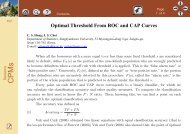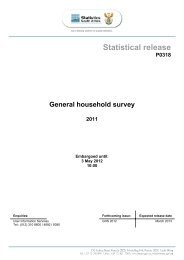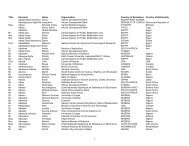Post-enumeration Survey (PES) - Statistics South Africa
Post-enumeration Survey (PES) - Statistics South Africa
Post-enumeration Survey (PES) - Statistics South Africa
Create successful ePaper yourself
Turn your PDF publications into a flip-book with our unique Google optimized e-Paper software.
<strong>Statistics</strong> <strong>South</strong> <strong>Africa</strong><br />
62<br />
• Gross Difference Rate (also Off-Diagonal Proportion). The gross difference rate (GDR) is<br />
calculated for the characteristic as a whole. It is the number of discrepancies between the census<br />
responses and the <strong>PES</strong> responses relative to the total number of persons matched. It is equivalent to<br />
the sum of all cells off the diagonal, for all categories, or the complement of the sum of the diagonal<br />
cells.<br />
• Rate of Agreement. The rate of agreement is the complement of the gross difference rate. A low<br />
rate of agreement indicates a high degree of variability, and vice versa.<br />
Table 21: Standards for the interpretation of the different content error measures<br />
Measure Low Moderate High<br />
Index of inconsistency 50<br />
Aggregate index of inconsistency 50<br />
Absolute value of NDR relative to mean<br />
or proportion (NDR/P) 0,05<br />
Source: 'Evaluating censuses of Population and Housing', ISP-TR-5, US Census Bureau, 1985<br />
Important note<br />
The estimated person totals shown in the content analysis tables do not coincide with the final census<br />
totals for each characteristic because:<br />
• they are based only on the sample of census records in the <strong>PES</strong> and are, therefore, subject to<br />
sampling variability;<br />
• they include only matched cases, not the full sample;<br />
• the data are unedited, while the data in the final census totals are edited;<br />
• they include only the in-scope sub-universe (consisting of housing units and hostels within in-scope<br />
EA types) while the final census totals include the full universe; and<br />
• they are unadjusted while the final census totals are adjusted for coverage error.<br />
The sole purpose of these totals is to compare the census responses with the <strong>PES</strong> responses for<br />
consistency/variability analysis purposes. They are not intended for socio-demographic analysis<br />
purposes; final census results should be used for such purposes. The data quality in the final census<br />
results is, to a certain extent, greatly improved over what the content analysis indicates due to more<br />
accurate data capturing (by automated scanning with rigorous quality control systems) and to<br />
sophisticated editing procedures.<br />
<strong>Post</strong> Enumeration <strong>Survey</strong> (<strong>PES</strong>)















